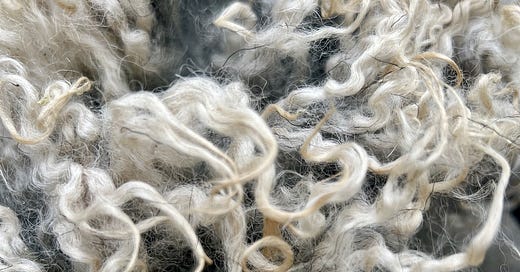"Shorn after wind and rain", was the woolbroker's sentence that sold me the autumn harvested Gute lamb's fleece. I had no plans of adding another fleece to my stash, but this one called to me with coaxing curls. The breed is primitive and the oldest one in Sweden, horned and with a flora of colours, structures and shapes in the fleece. I collect the parcel from the package delivery, a grocery bag from Ica Supermarket Högbyhallen, bundled into a ball and wrapped with several rounds of transparent package tape. 1.1 kg, Gute lamb no. 8 is scribbled on the side. When I release the fleece from its paper prison it poofs up as if taking the biggest breath after having held it for days. It keeps inhaling, slowly, until the mass is relaxed, staples quietly reaching, whisker-like. The autumn wind trapped between the fibers blends with the new setting and releases the comforting smell of sheep right there in my living room, miles away from the pastures.
The fleece offers me every thinkable shade of grey. Curls of all flavours cover the surface. In each staple an ingenious architecture of baby fine undercoat for warmth, long and adolescent outercoat to keep moisture off the sheep. The coats accompanied by that armouring foundation called kemp – rough, short and quirky fibers, prone to breaking and quick to fall out, but also vital for keeping the staple structure open and upright to protect the sheep from the wind and the rain it was shorn in. Some dirt, a few juniper needles, pieces of grass and one or two timothy seeds, wool grease and sheep sweat all mingle in the wooly cloud. I don’t know the sheep, its name or its owner, but I do trust the broker to deliver first class wool, and she does.
I look at the bundled fleece and try to put the sections together as they grew on the sheep; the shortest, finest and curliest around the neck, isn't that where you would want the very softest and kindest of yarns? Long and billowing on the upper sides for a warm sweater, rougher around the legs in a pair of socks. The dirty and poopy bits have been removed already, perhaps saved for scattering over the kaleyard, protecting the soil against dehydration, and an excellent fertilizer. The fleece, engineered through millennia, guides me to the perfect yarn for shielding my own body just as the fleece once shielded the sheep, now happily growing herself a new one.
I marvel at the staples, “look at this beauty, and this one!” While I lose myself in the fiber forest, the captured autumn wind blends with my midwinter thoughts – of my ill father, my worried mother, of peeling carrots and when did I get that hole in my sock? They will keep hovering as I spin the wool into early summer yarn and secure them in a textile. Next autumn I may drape myself in fragments of those memories as I wear knitted garments in new autumn winds. Perhaps I’ll use the fleece for teaching, for students to wonder at, spin their own stories into and enrich the world with.
I look out into the frosty February morning, the fog telling me there won't be much of a breeze today, but still, something from this moment will sneak between the fibers and settle, sighing.







It’s beautiful, with far more texture than fleeces from my local sheep..
Wonderful words, especially finding a poetic way to describe the unwrapping of a parcel. I was there with you virtually feeling the fleece.